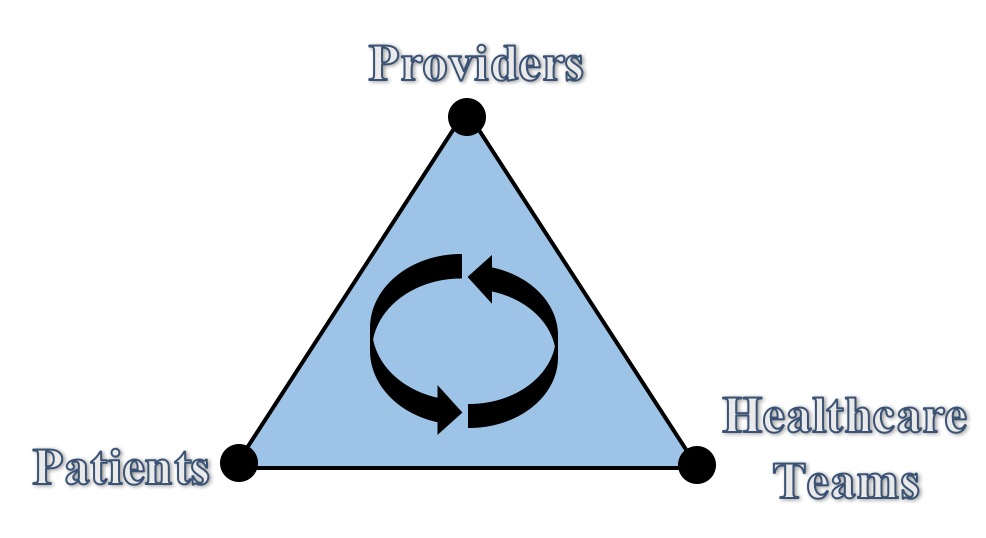Electronic Health Records as a Work-in-Progress
By Keri Stephens and Ashley K. Barrett
Last time you visited your physician, did you notice he or she was recording your symptoms and other diagnostic information into a computer? Have you ever wondered what’s on the screen? What exactly is he or she typing and why? Today most healthcare providers use electronic health record (EHR) systems to document and track patient care, and quite often patients also can access this information through online portals. While there are some very valuable reasons to use these systems, as William Tierney, MD and Chair of Population Health at the Dell Medical School and his global teams have established, there are also some human challenges.
We think of EHR access in terms of a connected triangle. The three points represent patients, providers, and teams. Patients notice the presence of these health information technologies when providers type into computers or portable technologies, like iPads. The mere presence of these screens in patient rooms can change the communication between the patient and the provider. But people often forget that EHR systems are also used by teams of care providers, and that creates a new level of complexity.

EHR systems are versatile—more versatile than one might think. Not only are these systems comprised of specific interfaces filled with icons, multiple drop-down menus, and multi- columned pages overflowing with patient data, they can also be individually tailored to meet the specific needs of healthcare organizations and teams. One physician in our recently published study provided a nice example of the level of development of the EHR system in his office. He told us to imagine buying a home. But instead of getting a move-in-ready shelter, we receive a U-Haul truck packed to the brim with wood planks, nails, cement, brick, and roofing. It’s then up to us to decide how to customize and construct the home based on our family’s needs. EHR systems function in much the same way.
So, in reality, EHR systems are not fixed, predictable technologies; they need to be adapted to meet the unique needs of healthcare teams. And this often depends on the types of services a healthcare center is providing. It is likely that a primary care facility will have different needs than an outpatient surgery center. Number of patients and length of care are two ingredients that can cause these two facilities to have different basic criteria for an EHR. Yet even if a healthcare team makes proactive decisions in their EHR design and vendor choice, the system must still be adapted over time to meet the evolving needs of the organization.
In the 1990’s and early 2000’s, organizational scholars Marshall Scott Pool and Geraldine DeSanctis studied teams who used shared software systems as an integral part of their work. Their research, across many different types of teams and organizations, found that even when a technology designer thinks the software has everything a team needs, the team will still adapt it to meet their needs. Think about your own mobile phone. Do you really use every feature that the designers put into the device? Furthermore, do you use it exactly like others around you?
One added complication with a team’s use of EHR systems is that they also interact face-to-face, even though the timing of those interactions is not necessarily predictable. In our research, just published in May, 2017, we found that when teams talk about the EHR system, those conversations influence their attitudes toward and use of EHR systems. For example, if team members are complaining about the system’s usability, that pessimism becomes contagious. Other team members will catch this negative attitude and view the implementation of an EHR system as unsuccessful. But, if individuals make changes to the system, presumably to make it better fit their work environment, their EHR attitudes become more positive.
Now we’re going to use a word that could make some people shutter: workarounds. Workarounds are often equated with mischievously slapping a Band-Aid on a flawed system that routinely doesn’t work. Yet healthcare workers regularly create workarounds—either inside the EHR systems or through off-line practices—to make these systems functional and work on the frontlines of healthcare. While we could view these system changes as problematic, past organizational research would suggest that this behavior is normal, and probably needed as teams interact with technologies and discover their possibilities. The problem resides, not necessarily in the workaround, but in our refusal to discuss workarounds. Just like discussions of quality and safety in healthcare, we should communicate about breaches in protocols, near misses, and errors in recording EHR information. These systems are still new, and EHR workarounds should be considered resources for learning and for building the more efficient EHR systems of tomorrow.
An added complication to consider with EHR systems is that some providers—specifically specialists working in multiple care facilities—move between locations. Because of this, they could have four different EHR vendors’ systems they need to learn and use. Given that we do research in two different locations, Keri Stephens is in Austin, and Ashley Barrett is in Waco, we can see concrete differences between the interconnectedness of healthcare facilities in a given geographic community. Waco is fairly centralized on EpicCare, while Austin healthcare facilities use a wide variety of vendors.
Many of the ideas we share about EHR systems, also apply to other health information technologies. Healthcare providers use different mobile devices, mobile applications, and technology-communication tools specific to their profession. We are continually conducting research in this area to better understand the growing needs of all healthcare stakeholders.


